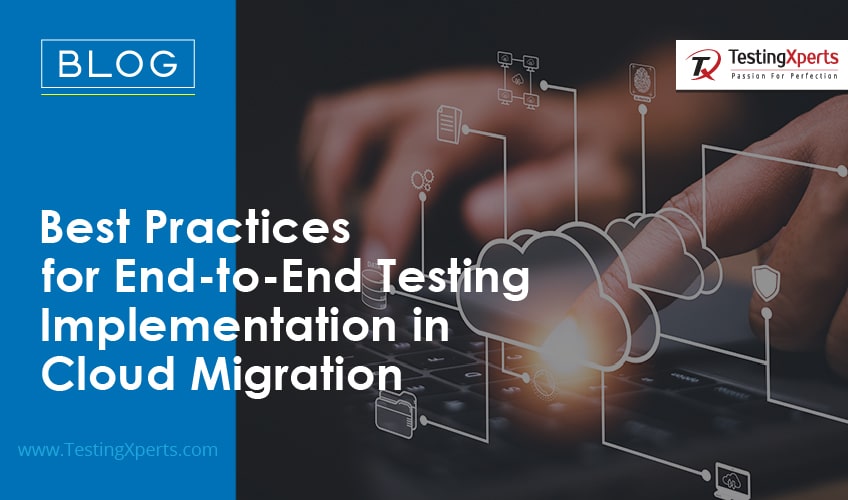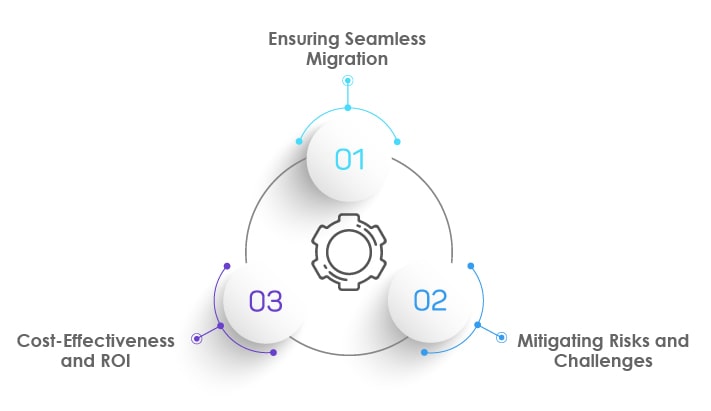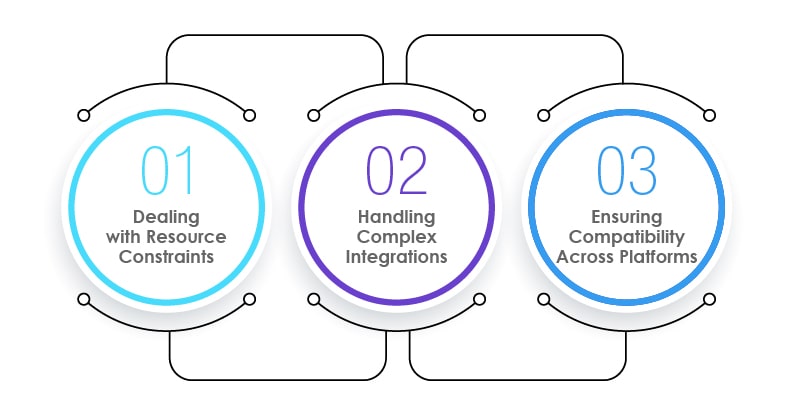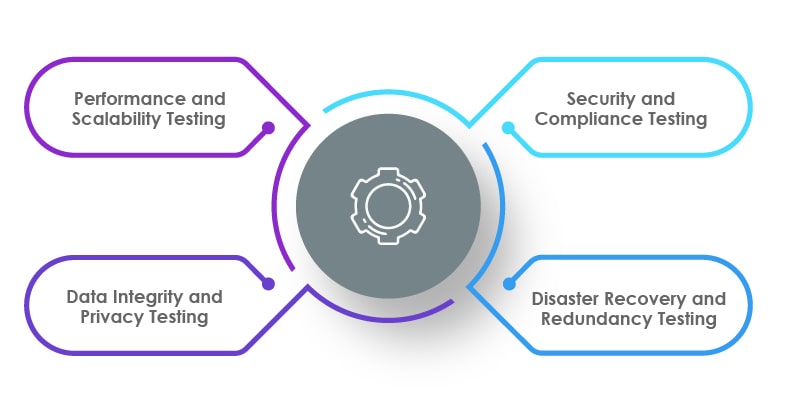Recommended Blogs
Best Practices for End-to-End Testing Implementation in Cloud Migration

Migrating to the cloud is no longer just a technological trend, it is a strategic choice for modern businesses seeking to optimize performance, enhance scalability, and achieve cost effectiveness. But, to ensure a successful migration, we must recognize the importance of End-to-End Testing.
Cloud Migration has driven digital transformation by transitioning on-premises applications and data to cloud environments. It enables organizations to support flexibility, stimulate innovation, and adapt to rapidly changing market demands. However, it comes with its challenges and uncertainties and that is where end-to-end testing comes into play.
Importance of End-to-End Testing
Let’s assume there’s an organization whose critical systems now reside on the cloud—a complex ecosystem interconnected by data threads. End to end testing serves as the bedrock, upon which the reliability and performance of this interconnected web rely. Detecting vulnerabilities, optimizing workflows, and enhancing user experience become possible through this rigorous testing approach.
Through active testing, businesses can eliminate lurking risks and bottlenecks that might impede their progress. It enables delivery of a product and an experience—seamless, secure, and second to none. By validating the complete flow of data and processes, this testing methodology ensures that every component of the application ecosystem works seamlessly in the cloud. It helps identify bottlenecks, security loopholes, and integration glitches that might otherwise hamper the seamless functioning of the systems.
Benefits of End-to-End Testing in Cloud Migration

By leveraging the power of end-to-end Testing, businesses can unlock the true potential of their cloud migration process. Following are some of the benefits that E2E testing offers:
Ensuring Seamless Migration
A successful cloud migration hinges on ensuring a seamless transition of critical applications and data. E2E Testing empowers organizations to perform comprehensive User Acceptance Testing across the entire ecosystem. By validating each step of the migration process, from data transfer to application functionality, businesses can confidently move their operations to the cloud without disruption. Seamlessly migrating to the cloud enables organization to embrace agility and unlock newfound potential.
Mitigating Risks and Challenges
In any cloud migration project, security risks are always there. End-to-End Testing helps identify potential bottlenecks, vulnerabilities, and compatibility issues before they can negatively impact the system. UAT testing highlights security vulnerabilities, compliance gaps, and data integrity concerns, allowing testers to address them proactively. Implementing comprehensive testing mitigates risks, improves security infrastructure, and ensures regulatory compliance—a crucial aspect for businesses operating in a dynamic digital landscape.
Cost-Effectiveness and ROI
Every investment must yield a substantial return. End-to-End Testing proves its worth by optimising the utilisation of cloud resources and streamlining application performance. Businesses can allocate resources optimally and enhance cost-effectiveness by detecting and rectifying performance inefficiencies. A well-executed testing strategy boosts return on investment (ROI) by reducing downtime, improving customer experiences, and fostering a culture of innovation.
Understanding Cloud-specific Testing Scenarios
To achieve a seamless and successful cloud migration, comprehensive E2E Testing is necessary. Cloud-specific testing scenarios are designed to address cloud environments’ unique challenges and validate the robustness of cloud-based solutions. Let’s explore some scenarios in the following:
Performance and Scalability Testing
Performance testing in the cloud involves evaluating cloud-based applications’ responsiveness, stability, and efficiency under varying loads. This testing assesses the application’s response time, throughput, and resource utilisation performance. Scalability testing, on the other hand, evaluates the ability of the cloud infrastructure to handle increasing workloads and scale resources dynamically.
Key Considerations:
Load Testing:
Simulating real-world user traffic to measure the application’s response time and resource consumption under different load conditions.
Stress testing:
Determining the system’s breaking point by applying heavy loads to assess its stability and responsiveness.
Autoscaling validation:
Automatically tests the cloud’s ability to scale resources based on demand and traffic fluctuations.
Geographic load distribution:
Evaluating performance across different geographic locations to identify latency issues.
Security and Compliance Testing
Cloud environments demand stringent security measures to protect data, applications, and resources. Cloud security testing identifies vulnerabilities and ensures compliance with relevant industry standards and regulations.
Key considerations:
Vulnerability assessments:
Scanning for potential security flaws and weaknesses in cloud applications and infrastructure.
Data encryption and privacy:
Verifying that data is appropriately encrypted in transit and at rest to maintain privacy.
Access controls and authentication:
Testing user access controls and authentication mechanisms to prevent unauthorised access.
Compliance validation:
Ensuring the cloud environment meets specific regulatory requirements, such as GDPR, HIPAA, or PCI DSS.
Data Integrity and Privacy Testing
Data integrity testing verifies the accuracy and consistency of data stored and retrieved in the cloud. Privacy testing ensures that sensitive information is protected and only accessible by authorised individuals.
Key Considerations:
Data validation: Checking data accuracy during upload, retrieval, and manipulation.
Data masking: Masking sensitive data in non-production environments to protect privacy during testing.
Access logging and auditing: Ensuring that access to data is logged and audited for compliance and security purposes.
Secure data deletion: Validating that data is thoroughly removed from storage when no longer required.
Disaster Recovery and Redundancy Testing:
Disaster recovery testing ensures the cloud infrastructure can recover from failures and disruptions efficiently. Redundancy testing assesses the system’s ability to handle hardware or software failures without significant service disruption.
Key Considerations:
Failover testing:
Testing the ability to switch from a failed component to a backup component without downtime.
Backup and recovery testing:
Verifying that data can be successfully backed up and restored in case of data loss.
Geographical redundancy:
Assessing data and service redundancy across multiple data centres or regions for increased resilience.
Disaster recovery drills:
Conduct simulated disaster scenarios to evaluate the effectiveness of recovery plans.
Addressing Common Challenges in End-to-End Testing

Let us look into some common challenges that may arise during E2E Testing and uncover the strategies to overcome them:
Dealing with Resource Constraints
Resource limitations can pose a significant impact on conducting comprehensive E2E Testing. Businesses can balance testing depth and resource efficiency by adopting intelligent test prioritisation and leveraging cloud-based testing platforms. Moreover, engaging with cross-functional teams and stakeholders early in the testing process can align everyone towards a unified goal, ensuring that the limited resources are allocated wisely.
Handling Complex Integrations
The interconnectivity of modern applications often gives rise to integration challenges during E2E Testing. To resolve these issues, testers can verify each integration point by breaking down the testing process into manageable phases. Additionally, automated testing frameworks streamline the validation process, allowing you to focus on resolving critical issues and ensuring seamless communication between integrated components.
Ensuring Compatibility Across Platforms
The cloud ecosystem encompasses many platforms, each with unique specifications. By adopting a device-agnostic approach and utilising cloud-based testing environments, you can efficiently validate your applications across various platforms and devices. Embracing responsive design principles and conducting usability testing ensures your applications adapt seamlessly to different screen sizes and interactions, providing exceptional user experiences.
Best Practices for Implementing End-to-End Testing

Implementing end-to-end testing in cloud migration requires careful planning and execution to ensure its effectiveness. Here are some best practices to consider:
Define Clear Objectives:
Clearly outline the objectives and goals of end-to-end testing for the cloud migration. Understand what aspects you want to validate and what results you expect to achieve through testing.
Create Comprehensive Test Plans:
Develop detailed test plans that cover all aspects of the application’s functionality, integration, performance, security, and scalability. Align these test plans with the specific requirements of the cloud environment.
Automate Testing where Possible:
Use test automation tools and frameworks to automate repetitive and time-consuming test cases. Automation helps increase test coverage, reduce human error, and allows for faster testing iterations.
Replicate Production Environment:
Set up a test environment that resembles the production cloud environment. This ensures that testing accurately reflects the real-world conditions and potential challenges of migration.
Perform Pre-Migration Testing:
Conduct preliminary testing before migrating to assess the application’s compatibility with the cloud environment. It allows you to identify and address any issues proactively.
Data Management and Security:
Ensure data migration is thoroughly tested and data integrity is maintained throughout the migration process. Address any data security concerns and comply with relevant regulations.
Simulate Real-World Scenarios:
Design test scenarios that mimic real-world user interactions and application usage patterns. It includes testing with varying workloads and traffic loads to assess the cloud environment’s scalability and performance.
Monitor and Analyse Performance:
Utilise performance monitoring tools during testing to measure and analyse application performance in the cloud environment. Identify performance bottlenecks and optimise resources as needed.
Test Disaster Recovery and Redundancy:
Test the cloud environment’s disaster recovery capabilities and redundancy mechanisms. Ensure that failover and backup procedures work as expected.
Collaboration and Communication:
Foster collaboration between development, testing, and operations teams to facilitate seamless testing and migration. Encourage open communication to address any issues promptly.
Regression Testing:
Conduct regular regression testing throughout the migration process to ensure that new updates and changes do not introduce new defects or negatively impact existing functionality.
Monitor Cost and Resource Utilisation:
Keep track of cloud resource consumption during testing to understand the cost implications of the migration. Optimise resource utilisation to maintain efficiency and cost-effectiveness.
Test Security Controls:
Verify that all security controls and access permissions are configured in the cloud environment. Address any vulnerabilities or misconfigurations promptly.
Document Test Results and Lessons Learned:
Keep comprehensive records of test results and document lessons learned during testing. These insights can be valuable for future cloud migration projects.
Continuous Improvement:
Treat end-to-end testing as an iterative process, continuously improving test cases and procedures based on feedback and experiences gained during the cloud migration.
Why Choose TestingXperts for End-to-End Testing?
TestingXperts is a leading provider of end-to-end testing services for cloud migration, offering a comprehensive suite of solutions to ensure a smooth and successful transition to the cloud. When considering cloud migration and the associated testing requirements, several key differentiators set TestingXperts apart from the competition:
Expertise in Cloud Technologies:
TestingXperts boasts a team of skilled professionals with extensive expertise in various cloud platforms and technologies. Whether it’s Amazon Web Services (AWS), Microsoft Azure, Google Cloud Platform (GCP), or other cloud providers, TestingXperts has in-depth knowledge of the nuances and challenges specific to each platform.
End-to-End Testing Services:
TestingXperts provides end-to-end testing services throughout the entire cloud migration process, from the initial assessment and planning phase to post-migration support. This comprehensive approach ensures that every aspect of the cloud infrastructure and applications is thoroughly tested and validated.
Seamless Integration with Existing Systems:
Migrating to the cloud often involves integrating existing on-premises systems with cloud-based solutions. TestingXperts validates the seamless integration of legacy systems with cloud environments, ensuring uninterrupted business processes.
Performance and Scalability Assurance:
TestingXperts’ focus on performance and scalability testing ensures that cloud applications can handle varying workloads and maintain optimal performance even during peak times. It guarantees a positive user experience and eliminates potential performance bottlenecks.
Security and Compliance Expertise:
Security is a top priority for any cloud migration initiative. TestingXperts possesses extensive experience in security and compliance testing, identifying vulnerabilities and ensuring adherence to industry standards and regulatory requirements.
Robust Test Automation Framework:
Leveraging a robust test automation framework, TestingXperts accelerates testing cycles, reduces manual effort, and enhances overall testing efficiency, resulting in cost savings and quicker time-to-market.
Conclusion
Successful cloud migration requires a robust and comprehensive testing approach to ensure a seamless transition and optimal performance in the cloud environment. TestingXperts offers a range of end-to-end testing services specifically tailored to address the unique challenges of cloud migration. By emphasising performance, security, data integrity, and disaster recovery, our experts empower organisations to achieve a seamless cloud migration experience, maximising the advantages of cloud technologies while safeguarding critical assets and sensitive data. Contact us now to take the first step towards a seamless cloud transition.
Discover more

